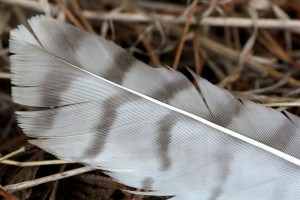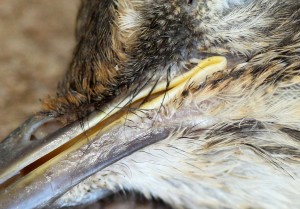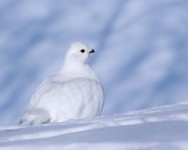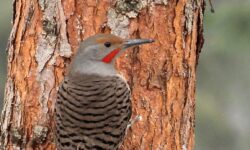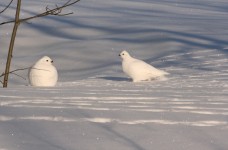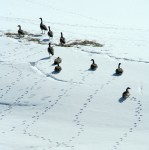A single feather lying in the grass. The straight shaft surrounded by colorful vanes, some askew with dampness. Singly a feather doesn’t accomplish much but collectively feathers enable birds to fly–and much more.
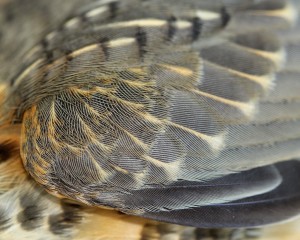
Contour feathers are arranged much like shingles on a roof in order to shed rain and keep the body dry.
Feathers help birds stay warm or cool, camouflage them from predators, help attract a mate, keep eggs and chicks warm, and help the bird defend themselves. Not every feather supports all these roles, instead there are several different types of feathers.
The most recognizable feathers are the contour feathers that create the shape and color of the bird. They range from the strong wing feathers of eagles to the stiff tail feathers of woodpeckers.
Most contour feathers exhibit the typical shape one thinks of when referring to feathers: a central shaft with soft vanes on both sides. The shaft closest to the body without any vanes is called the calamus and is hollow. The remaining shaft with vanes is called the rachis and is solid.
The vanes consist of barbs arranged side by side up the shaft. Small barbules grow from the barbs and each barbule has tiny hooks, much like Velcro, that interlock and ultimately keep the barbs locked together.
Not every feather includes all of these structures.
Bristles, a highly specialized contour feather, have an especially stiff rachis and lack barbs on the outermost part of the feather. Many insect-eating birds, such as flycatchers, nightjars and robins, have bristles surrounding their beak to help protect their eyes from wriggling prey and provide feedback much like a cat’s whiskers.
Down feathers have a greatly reduced rachis or no rachis and the barbules lack hooks which results in a soft, fluffy feather. Anyone with a down jacket knows how warm down feathers can be because of that fluffiness. By being fluffy, the barbs trap air in pockets that act as insulation whether on a baby bird, adult bird or in a down jacket.
Baby chicks that immediately walk or swim are covered with down feathers which gives them their fluffy appearance.
Halfway between down feathers and contour feathers are semiplumes. Semiplumes have a supportive rachis but lack the hooks that hold the barbs together. They are found between other feathers and provide additional warmth and shape.
All of these feathers aren’t randomly scattered across the bird’s body. Instead feathers are found in linear tracts called pterylae. The densest feather tracts are typically found on the head and neck–unless you’re looking at a turkey vulture.
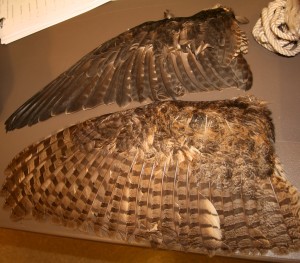
The long wing feathers are contour feathers. Each contour feather is attached to a special muscle that can move the feather to the desired position
Areas on the body without feathers are called apteria. Featherless areas often include parts of the neck, abdomen and under the tail.
When birds begin to lay eggs, the female loses feathers on her abdomen to create a brood patch. The bare skin provides skin-to-egg warmth during incubation. Even male birds that help with incubating develop a brood patch.
Once hatched, the baby chicks are either covered in down feathers or are bare-skinned depending on whether they immediately leave the nest or not. Either way, the chicks will eventually grow feathers so they look like adults.
Whether 946 feathers for a hummingbird or 25,216 feathers for a swan, birds will grow and replace their feathers many times throughout their life. Look in next week’s column for reasons why a single feather can be found lying on the grass.

